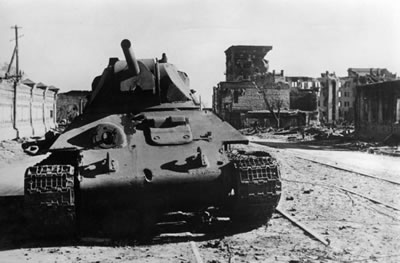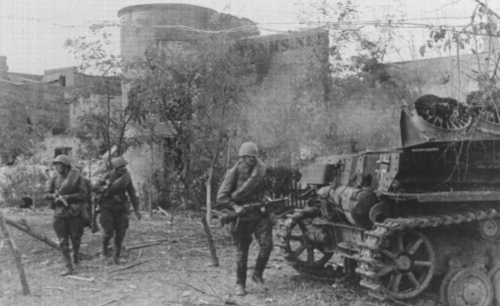The Battle of Stalingrad during World War II was one of the bloodiest battles in history, resulting in almost two million casualties. Ultimately resulting in a German defeat, it is often considered the turning point of the war in Europe.
After Operation Barbarossa, fighting between Germany and the Soviet Union continued, with the Soviets driving the Germans back a little bit.
The Germans, with fewer resources, decided to focuses on defeating forces in the south of the Soviet Union, then moving then moving into the Caucasus and capturing the oilfields there.
At the same time, Rommel and his Afrika Korps would be moving east.
 A German offensive, codenamed Fall Blau (Case Blue) began in the summer of 1942.
A German offensive, codenamed Fall Blau (Case Blue) began in the summer of 1942.
At first, the Germans used their classic blitzkrieg method of attack – blasting through gaps in enemy lines.
The Soviets, despite having powerful T-34 and KV-1 tanks, were not able to handle the German assault.
Soviet command wasn’t able to deal with the speed of the German attack. The Soviet Army couldn’t figure out what was happening in time to give orders for an effective response.
However, counterattacks by the Soviets did cause problems for the Germans. At one time, the Soviets cut off six German divisions.
The Germans had trouble getting supplies. Soviets used a scorched earth policy to prevent the Germans from using captured fuel supplies.
Nevertheless, by the end of August 1942, the Germans had made a significant advance and had begun to encircle Stalingrad.
August 23, 1942 marked the beginning of a massive bombing campaign, with German planes dropping bombs on Stalingrad, starting many huge fires and killing 40,000 civilians. The city was left in ruins.
However, fighting continued to take place all over the streets.
By the middle of September, the Germans occupied a large portion of the northern bank of Stalingrad.
Nevertheless, fighting continued. At such close quarters, soldiers fought with knives and bayonets.
However, the Soviet army stood firm and by the winter, the Germans still had not won Stalingrad.
The Germans made fewer gains, and there were fewer opportunities for Panzer victories.

On November 19, 1942, the Soviets launched a counteroffensive known as Operation Uranus.
After heavy fighting, the Soviets were able to surround the Axis forces. By November 23, 1942, almost 300,000 Axis soldiers were trapped in and around Stalingrad.
Symbolically, Stalingrad was very important to Hitler. German high command decided that the trapped forces, led by General Friedrich Paulus, should not try to break out; they should stay inside Stalingrad.
Plans were made to supply the encircled forces by air. Supplies, however, were insufficient.
Eventually, 13 German divisions, which included three panzer divisions, were diverted from their drive toward the Caucasus to rescue the surrounded German forces at Stalingrad. The German offensive, known as Operation Winter Storm, began on December 12, 1942. It was led by a battalion of Tiger 1 tanks.
A three day tank battle, commencing on December 14, took place south of Stalingrad.
Hitler did not give orders for the German troops to leave Stalingrad, so they remained there.
On December 24, the Soviets launched another offensive, called Operation Little Saturn.
Paulus surrendered on February 2, 1943.